
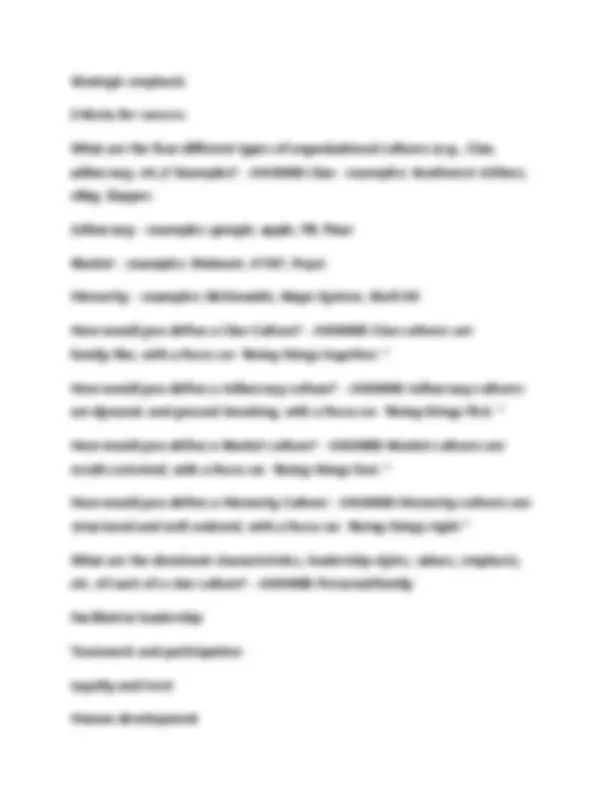
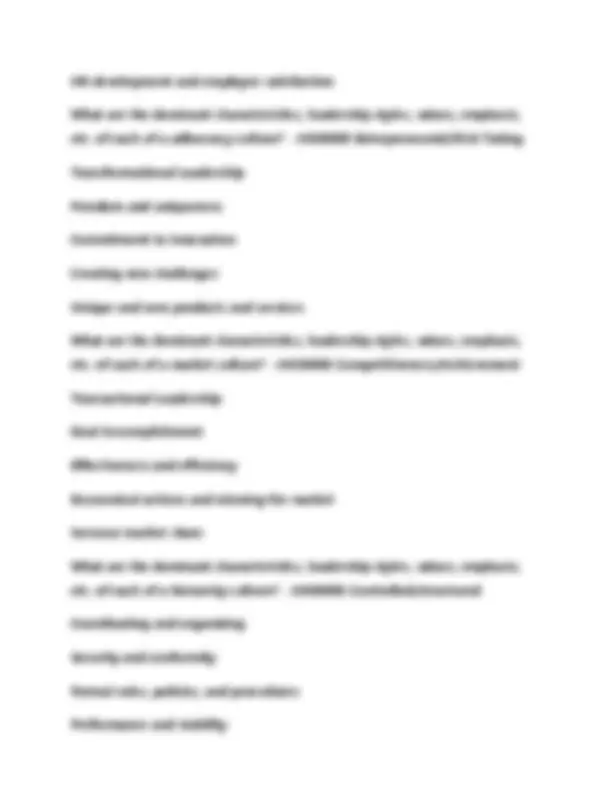
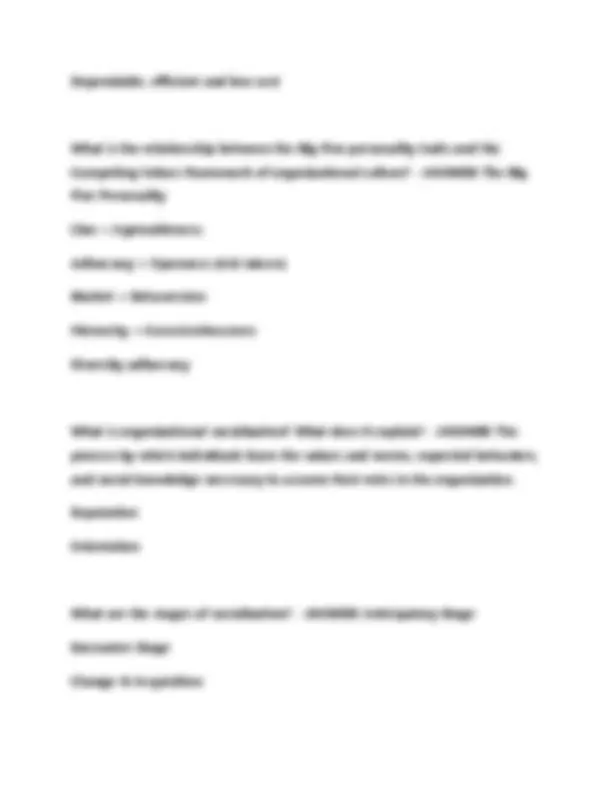
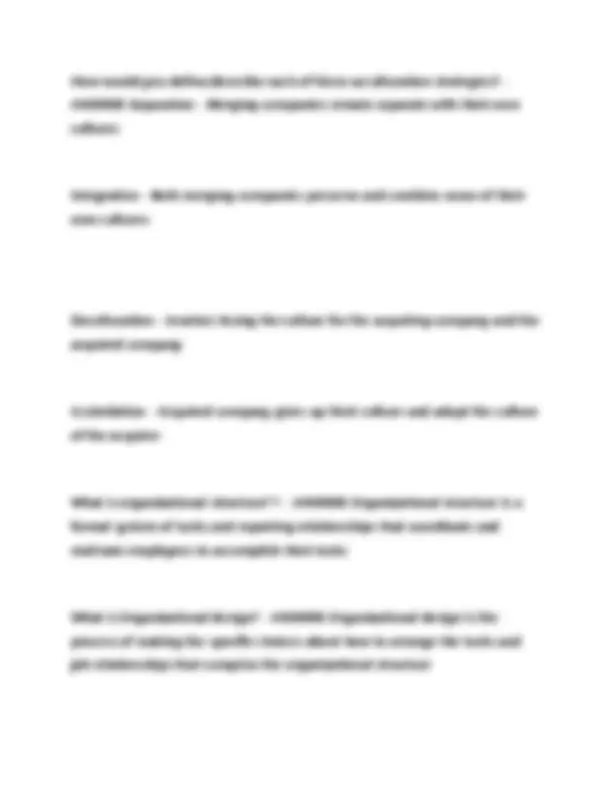
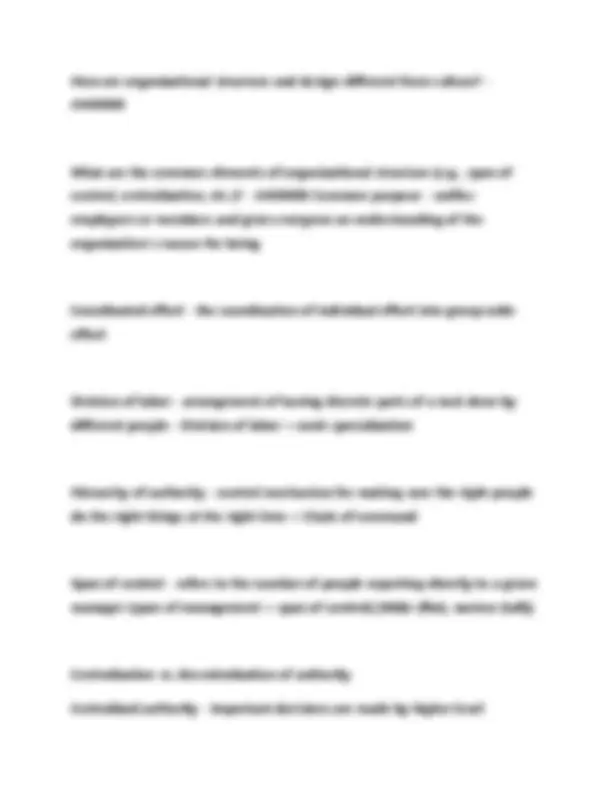
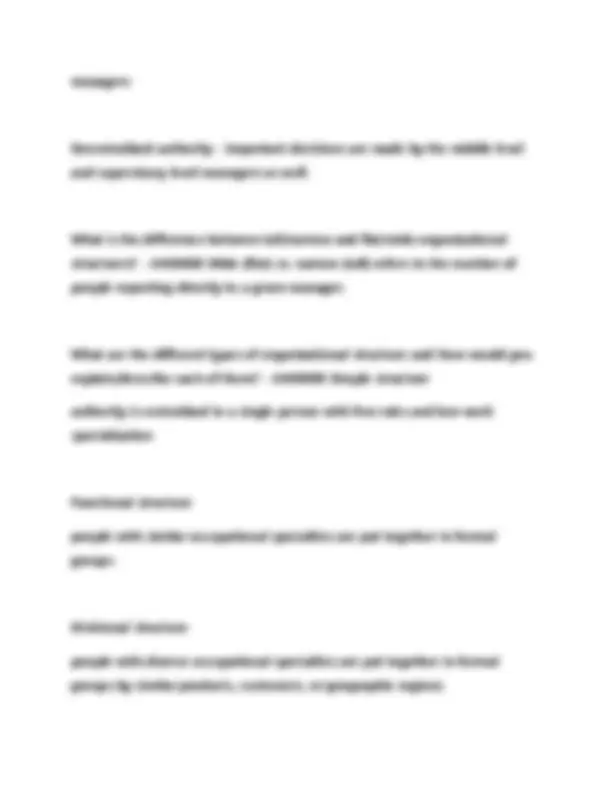
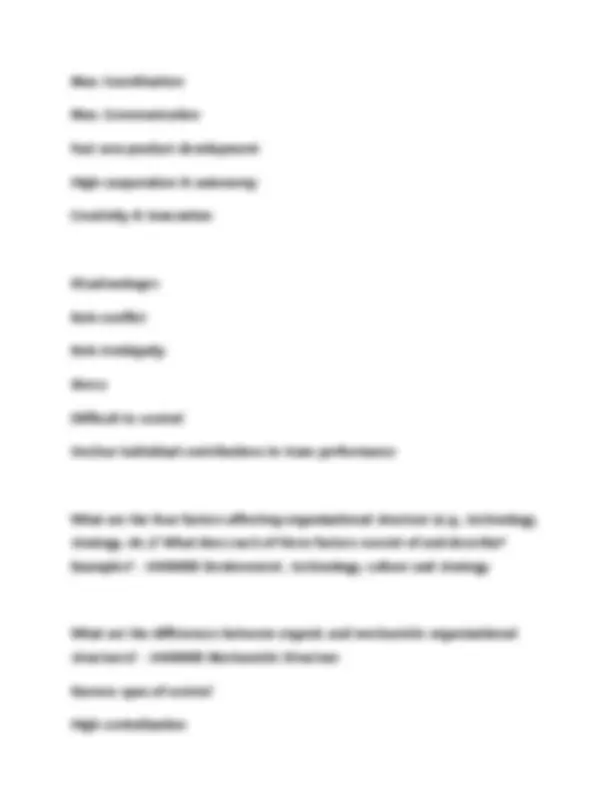
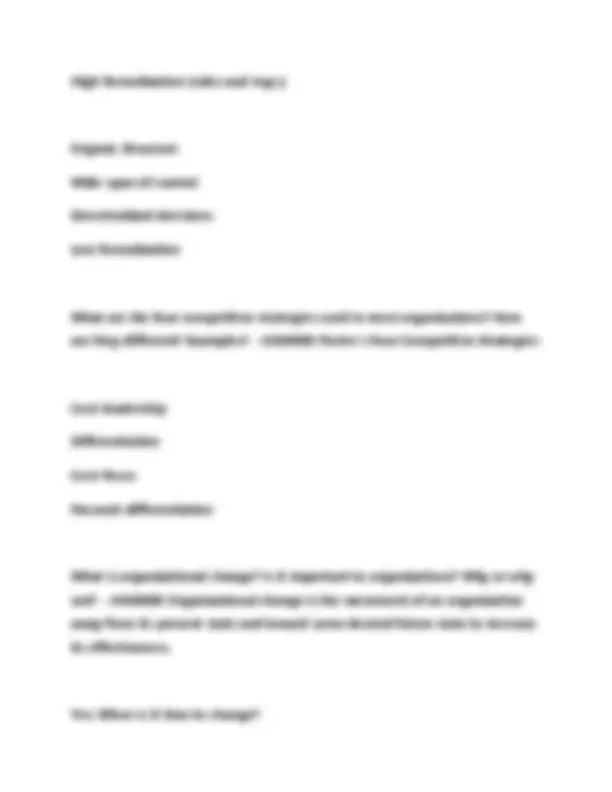
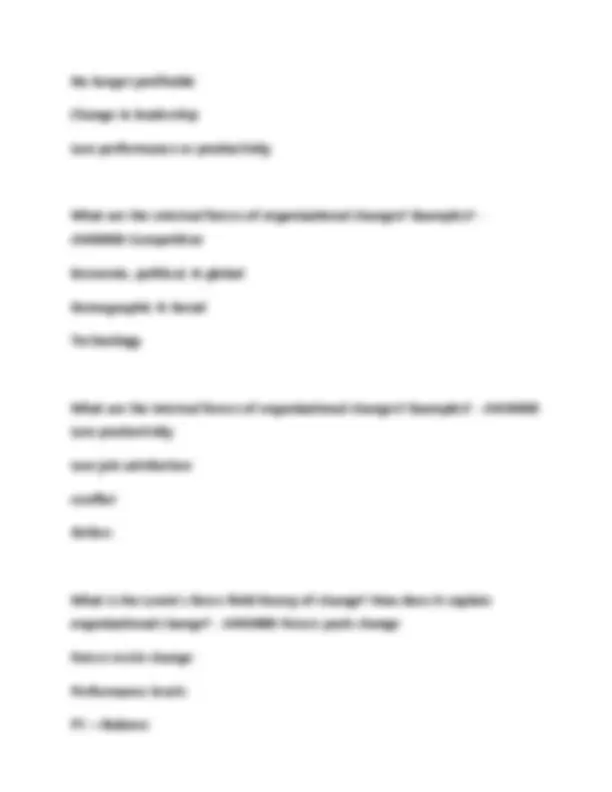
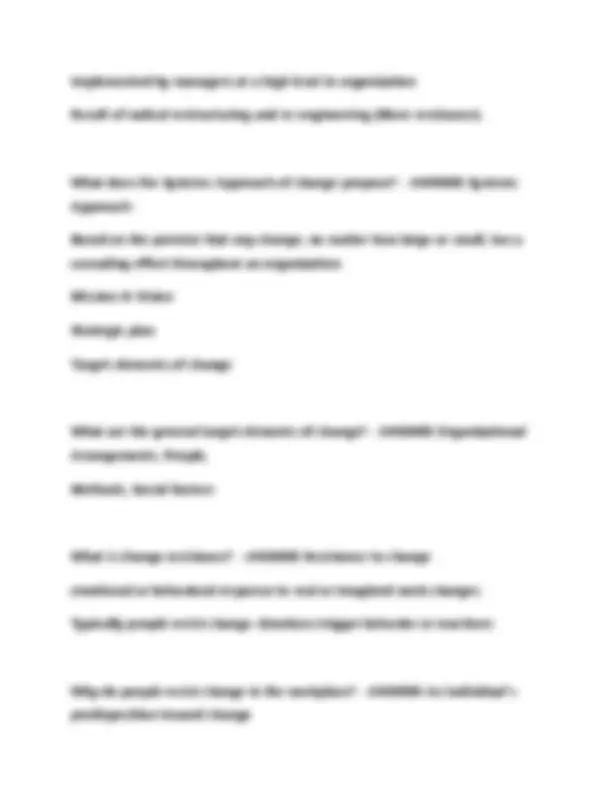
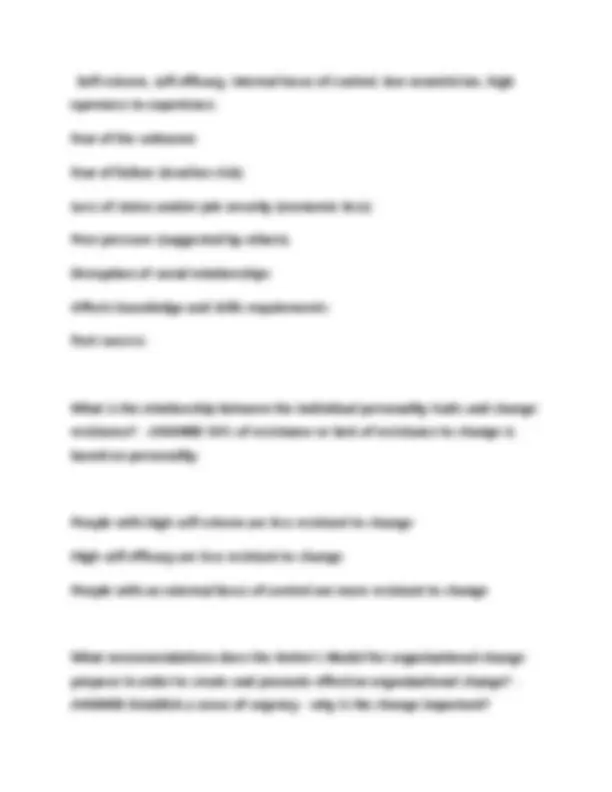
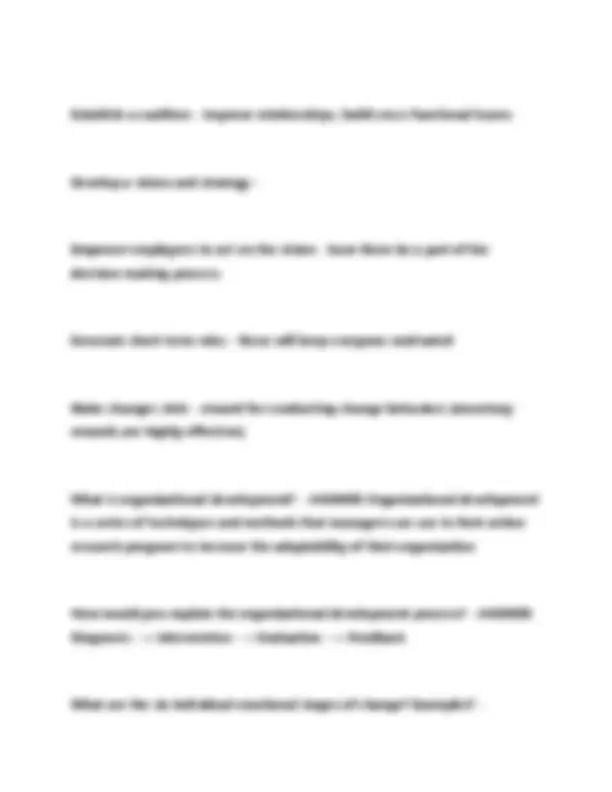
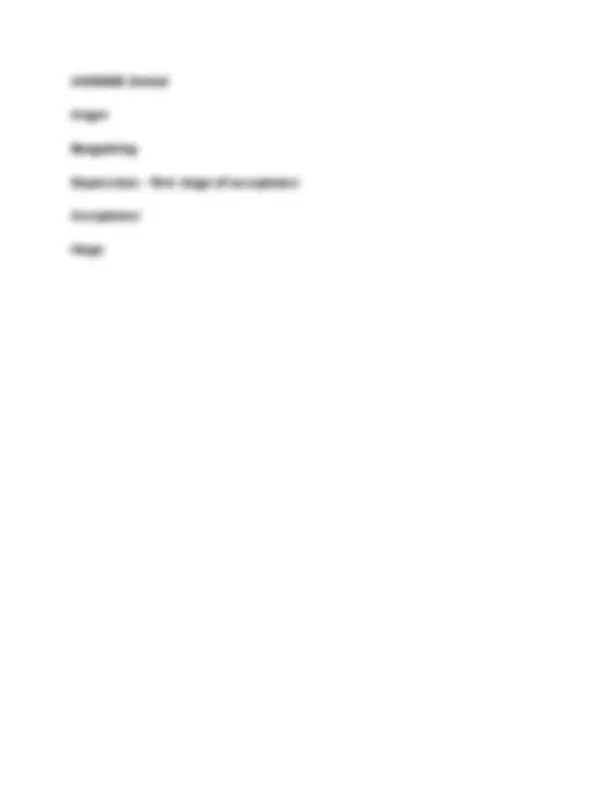


Study with the several resources on Docsity

Earn points by helping other students or get them with a premium plan


Prepare for your exams
Study with the several resources on Docsity

Earn points to download
Earn points by helping other students or get them with a premium plan
Community
Ask the community for help and clear up your study doubts
Discover the best universities in your country according to Docsity users
Free resources
Download our free guides on studying techniques, anxiety management strategies, and thesis advice from Docsity tutors
This document offers a comprehensive overview of organizational culture and structure, exploring key concepts such as the competing values framework, organizational socialization, and acculturation strategies. it delves into the different types of organizational cultures (clan, adhocracy, market, hierarchy), detailing their characteristics, leadership styles, and values. furthermore, it examines organizational structure, its elements, various types (simple, functional, divisional, matrix, team-based), and the advantages and disadvantages of each. The depth of analysis and clear explanations make it a valuable resource for students studying organizational behavior.
Typology: Exams
1 / 21

This page cannot be seen from the preview
Don't miss anything!














What is organizational culture? - ANSWER A system of shared beliefs and values that develops within an organization and guides the behavior of its members. How can organizational culture be described? - ANSWER Collection of beliefs, values, assumptions, etc.. Defines what is important Provides direction toward the "right way" of doing things Company's DNA/Personality Operates at different levels Influences our behavior at work Culture impacts behavior, behavior impacts performance Why is organizational culture important? - ANSWER There must be a fit between employee and culture to produce success. What are the three main levels of organizational culture? What do they describe and signify? Examples? - ANSWER Level 1: Workplace Observable Artifacts Physical manifestations - things you can see or observe in a culture (Tangible) Level 2: Values (Terminal/Instrumental)
Concepts, beliefs, convictions, etc. Terminal are end state values almost like goals (Innovation or profit) Instrumental values are values are methods or tools that you use to achieve terminal values. Level 3: Basic/Core Assumptions Core values - determined by the leaders of org. very hard to change, the existence of the org relates to these values What are the four functions of organizational culture? How do they work? - ANSWER Sense Making device - allows you to understand why people are the way they are or why orgs function a certain way Social system stability - rules or norms that are unwritten. Social norms that are expected. Occur naturally, informal UNWRITTEN Collective Commitment - creates long lasting commitment, one of the most powerful things... the company becomes part of you. Organizational Identity - shapes who you are What does the Competing Values Framework of organizational culture propose? - ANSWER The competing values can be understood based on six factors. Dominant Characteristics Leadership Styles Employee Management Organizational values
HR development and employee satisfaction What are the dominant characteristics, leadership styles, values, emphasis, etc. of each of a adhocracy culture? - ANSWER Entrepreneurial/Risk Taking Transformational Leadership Freedom and uniqueness Commitment to innovation Creating new challenges Unique and new products and services What are the dominant characteristics, leadership styles, values, emphasis, etc. of each of a market culture? - ANSWER Competitiveness/Achievement Transactional Leadership Goal Accomplishment Effectiveness and efficiency Economical actions and winning the market Increase market share What are the dominant characteristics, leadership styles, values, emphasis, etc. of each of a hierarchy culture? - ANSWER Controlled/structured Coordinating and organizing Security and conformity Formal rules, policies, and procedures Performance and stability
Dependable, efficient and low cost
What is the relationship between the Big Five personality traits and the Competing Values Framework of organizational culture? - ANSWER The Big Five Personality Clan = Agreeableness Adhocracy = Openness (risk takers) Market = Extraversion Hierarchy = Conscientiousness Diversity adhocracy
What is organizational socialization? What does it explain? - ANSWER The process by which individuals learn the values and norms, expected behaviors, and social knowledge necessary to assume their roles in the organization. Reputation Orientation
What are the stages of socialization? - ANSWER Anticipatory Stage Encounter Stage Change & Acquisition
Ethical behavior/CWB
How do you change organizational culture? - ANSWER Companies that try to change their cultures emphasize new: Organizational values and norms The managerial culture (e.g., relationships) Organizational policies, rituals, and ceremonies Culture symbols and other aspects physical culture
Typically, organizations hire people who fit into the new culture Attraction, Selection, Attrition (ASA
What is organizational acculturation? - ANSWER The process of psychological changes that employees experience in response to contact with other cultures
What are the four strategies of acculturation? - ANSWER Separation Integration Deculturation Assimilation
How would you define/describe each of these acculturation strategies? - ANSWER Separation - Merging companies remain separate with their own cultures
Integration - Both merging companies preserve and combine some of their own cultures
Deculturation - Involves losing the culture for the acquiring company and the acquired company
Assimilation - Acquired company gives up their culture and adopt the culture of the acquirer
What is organizational structure?? - ANSWER Organizational structure is a formal system of tasks and reporting relationships that coordinate and motivate employees to accomplish their tasks
What is Organizational design? - ANSWER Organizational design is the process of making the specific choices about how to arrange the tasks and job relationships that comprise the organizational structure
managers
Decentralized authority - important decisions are made by the middle level and supervisory level managers as well.
What is the difference between tall/narrow and flat/wide organizational structures? - ANSWER Wide (flat) vs. narrow (tall) refers to the number of people reporting directly to a given manager.
What are the different types of organizational structure and How would you explain/describe each of them? - ANSWER Simple structure authority is centralized in a single person with few rules and low work specialization
Functional structure people with similar occupational specialties are put together in formal groups
Divisional structure people with diverse occupational specialties are put together in formal groups by similar products, customers, or geographic regions
Matrix structure an organization combines functional and divisional chains of command in a grid so that there are two command structures-vertical and horizontal People and resources grouped by: Functions Products, Customers, Locations
Team-based structure work groups are used to improve relations and solve problems throughout the organization
What are the advantages and disadvantages of the functional structure? - ANSWER Advantages Specialization Efficiency Skill improvement Motivation
Disadvantages Limited growth under existing structure Limits to number of products and services
Max. Coordination Max. Communication Fast new product development High cooperation & autonomy Creativity & Innovation
Disadvantages Role conflict Role Ambiguity Stress Difficult to control Unclear individual contributions to team performance
What are the four factors affecting organizational structure (e.g., technology, strategy, etc.)? What does each of these factors consist of and describe? Examples? - ANSWER Environment , technology, culture and strategy
What are the differences between organic and mechanistic organizational structures? - ANSWER Mechanistic Structure Narrow span of control High centralization
High formalization (rules and regs.)
Organic Structure Wide span of control Decentralized decisions Low formalization
What are the four competitive strategies used in most organizations? How are they different? Examples? - ANSWER Porter's Four Competitive Strategies
Cost-leadership Differentiation Cost-focus Focused-differentiation
What is organizational change? Is it important to organizations? Why or why not? - ANSWER Organizational change is the movement of an organization away from its present state and toward some desired future state to increase its effectiveness.
Yes; When is it time to change?
P2 = Increase/reduce forces for change, or both
How does Lewin's Model explain the process of organizational change? What are the stages of change according to this model? What generally happens in these stages? - ANSWER Unfreezing - Unfreeze the organization from its present state & Bench-marking
Changing - Make the desired type of change in the organization & New information
Refreezing - Refreeze the organization in a new desired state & Integration of behavior
1.) Positive reinforcement is very helpful in the refreeze stage 2.) Modeling and coaching is important in all three phases 3.) monetary rewards are highly effective during refreeze
What is the difference between evolutionary and revolutionary organizational change? Examples? - ANSWER Evolutionary change is change that is gradual, incremental, and narrowly focused.
Revolutionary change is change that is rapid, dramatic, and broadly focused.
What are the two agents of change? - ANSWER External - consultants or experts in the process
Internal - leaders or managers
What is the difference between bottom-up and top-down change? - ANSWER Bottom-up: Implemented by employees at low levels and rises over time All levels involved in change process (Less resistance).
Top-down:
Self esteem, self efficacy, internal locus of control, low neuroticism, high openness to experience. Fear of the unknown Fear of failure (involves risk) Loss of status and/or job security (economic loss) Peer pressure (suggested by others) Disruption of social relationships Affects knowledge and skills requirements Past success
What is the relationship between the individual personality traits and change resistance? - ANSWER 50% of resistance or lack of resistance to change is based on personality
People with high self esteem are less resistant to change High self efficacy are less resistant to change People with an external locus of control are more resistant to change
What recommendations does the Kotter's Model for organizational change propose in order to create and promote effective organizational change? - ANSWER Establish a sense of urgency - why is the change important?
Establish a coalition - improve relationships, build cross functional teams
Develop a vision and strategy -
Empower employees to act on the vision - have them be a part of the decision making process.
Generate short-term wins - these will keep everyone motivated
Make changes stick - reward for conducting change behaviors (monetary rewards are highly effective).
What is organizational development? - ANSWER Organizational development is a series of techniques and methods that managers can use in their action research program to increase the adaptability of their organization
How would you explain the organizational development process? - ANSWER Diagnosis --> Intervention --> Evaluation --> Feedback
What are the six individual emotional stages of change? Examples? -